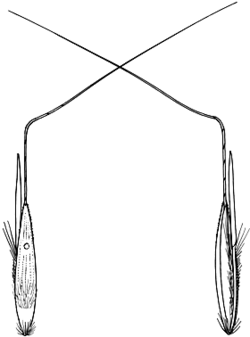Common name: Red Grass, Red-leg Grass
Bothriochloa macra (Steud.) S.T.Blake APNI* 
Description: Caespitose to decumbent perennial to 1 m high.
Leaves with ligule 1.5–2.5 mm long, minutely ciliate at apex; blade 2.5–5.5 mm wide, sparsely hairy with tubercle-based hairs.
Racemes 3–6, appressed or somewhat flabellate, 3–8.5 cm long, white-villous; joints and pedicels 3–5 mm long, the margins with hairs to 4 mm long. Sessile spikelet narrowly rounded at tip, the callus densely bearded with hairs to 1 mm long. Lower glume loosely hairy on the lower 30% or rarely glabrous, with a small pit on the back in the upper part or unpitted but often slightly depressed; upper glume slightly smaller, smooth. Lower lemma lanceolate-oblong to ovate to lanceolate, jagged at the apex, about 75% as long as the glumes; fertile lemma stipe-like; awn 2–2.5 cm long, geniculate; palea absent; stamens 3. Pedicellate spikelet sterile, lanceolate, acute, 4–6 mm long.
Flowering: summer.
Distribution and occurrence: Widespread in overgrazed pastures.
NSW subdivisions: NC, CC, SC, NT, CT, ST, NWS, CWS, SWS, NWP, SWP
Other Australian states: Qld Vic. S.A.
Text by S. W. L. Jacobs & C. A. Wall
Taxon concept: Flora of NSW 4 (1993)
APNI* Provides a link to the Australian Plant Name Index (hosted by the Australian National Botanic Gardens) for comprehensive bibliographic data
***The AVH map option provides a detailed interactive Australia wide distribution map drawn from collections held by all major Australian herbaria participating in the Australian Virtual Herbarium project.
|


